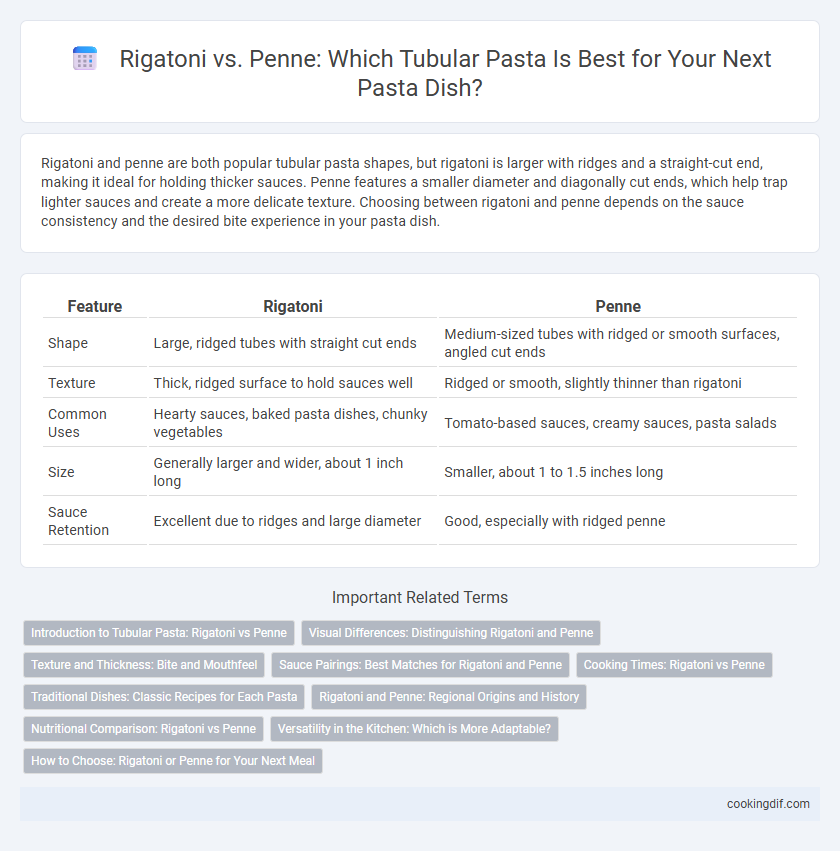Rigatoni and penne are both popular tubular pasta shapes, but rigatoni is larger with ridges and a straight-cut end, making it ideal for holding thicker sauces. Penne features a smaller diameter and diagonally cut ends, which help trap lighter sauces and create a more delicate texture. Choosing between rigatoni and penne depends on the sauce consistency and the desired bite experience in your pasta dish.
Table of Comparison
| Feature | Rigatoni | Penne |
|---|---|---|
| Shape | Large, ridged tubes with straight cut ends | Medium-sized tubes with ridged or smooth surfaces, angled cut ends |
| Texture | Thick, ridged surface to hold sauces well | Ridged or smooth, slightly thinner than rigatoni |
| Common Uses | Hearty sauces, baked pasta dishes, chunky vegetables | Tomato-based sauces, creamy sauces, pasta salads |
| Size | Generally larger and wider, about 1 inch long | Smaller, about 1 to 1.5 inches long |
| Sauce Retention | Excellent due to ridges and large diameter | Good, especially with ridged penne |
Introduction to Tubular Pasta: Rigatoni vs Penne
Tubular pasta varieties like rigatoni and penne are staples in Italian cuisine, known for their hollow shapes that effectively hold sauces. Rigatoni features larger, ridged tubes with straight edges, making it ideal for thick, chunky sauces and bakes. Penne, characterized by its smaller size and diagonally cut ends, pairs well with smooth or creamy sauces, balancing texture and flavor in various dishes.
Visual Differences: Distinguishing Rigatoni and Penne
Rigatoni and penne are both popular types of tubular pasta, but rigatoni is larger with straight-cut ends and pronounced ridges running along its surface, while penne is smaller with diagonally cut ends and smoother ridges. The straight, wide tubes of rigatoni allow it to hold thicker sauces inside its hollow center, whereas penne's angled edges create a more dynamic texture when paired with lighter sauces. Visual distinction is clear: rigatoni's robust size and straight edges contrast with penne's sleek, angled shape and more delicate ridges.
Texture and Thickness: Bite and Mouthfeel
Rigatoni features ridged, slightly thicker walls that provide a robust bite and a hearty, chewy mouthfeel ideal for holding chunky sauces. Penne has smoother, thinner tubes with a firmer texture and a more delicate bite, allowing sauces to lightly coat with every mouthful. The pronounced thickness and ridges of rigatoni enhance textural complexity, while penne offers a refined, consistent pasta experience.
Sauce Pairings: Best Matches for Rigatoni and Penne
Rigatoni's ridged surface and larger diameter make it ideal for chunky sauces like Bolognese and vegetable ragu, as the grooves trap thick, hearty ingredients effectively. Penne's smooth or ridged tubes excel with lighter sauces such as arrabbiata or pesto, allowing the sauce to coat each piece evenly without overwhelming the pasta's texture. Both pastas suit baked dishes, but rigatoni holds up better under heavy cheese and cream sauces, while penne provides a more balanced bite with oil-based or tomato sauces.
Cooking Times: Rigatoni vs Penne
Rigatoni typically requires a longer cooking time than penne due to its larger diameter and thicker walls, usually around 12-15 minutes compared to penne's 10-12 minutes. The hollow tubes of rigatoni allow for sauce retention, but its thickness demands careful attention to avoid undercooking. Penne's slimmer shape cooks faster and is ideal for lighter sauces or baked dishes where shorter cooking times are preferred.
Traditional Dishes: Classic Recipes for Each Pasta
Rigatoni, with its large, ridged tubes, is traditionally paired with hearty sauces like Bolognese and baked dishes such as Rigatoni al Forno, where its shape holds chunky meat and cheese blends effectively. Penne, known for its smaller, smooth or ridged diagonally cut tubes, is a staple in recipes like Penne alla Vodka and Pasta Primavera, where the sauce clings to the pasta's surface enhancing flavor distribution. Both pastas excel in classic Italian cuisine by complementing sauces and ingredients through their unique textures and shapes.
Rigatoni and Penne: Regional Origins and History
Rigatoni, originating in Southern Italy, is known for its large, ridged tubes that trap thick sauces, reflecting the hearty culinary traditions of regions like Campania and Sicily. Penne, with its origins in Northern Italy, particularly Liguria and Piedmont, features smaller, diagonally cut tubes ideal for lighter, olive oil-based or tomato sauces common in these areas. Both pastas have evolved over centuries, shaped by regional ingredients and cooking styles, making them staples in distinctly different Italian gastronomic cultures.
Nutritional Comparison: Rigatoni vs Penne
Rigatoni and penne both offer similar nutritional profiles, containing comparable amounts of calories, carbohydrates, and protein per serving, making them suitable options for balanced meals. Rigatoni's larger, ridged tubes may hold more sauce, potentially increasing overall calorie intake depending on the sauce used. Penne's smaller size and smooth or ridged surface provide versatility in portion control and pairing with lighter or vegetable-based sauces for lower calorie meals.
Versatility in the Kitchen: Which is More Adaptable?
Rigatoni's larger diameter and ridged surface capture chunky sauces and baked dishes effectively, making it ideal for hearty recipes. Penne's smaller size and diagonal cuts provide a smoother texture, excelling in cold pasta salads and lighter sauces. Both rigatoni and penne offer versatility, but rigatoni is generally more adaptable for robust, baked, or chunky sauce dishes while penne suits a wider range of textures and plating styles.
How to Choose: Rigatoni or Penne for Your Next Meal
Choose rigatoni for hearty sauces and chunky ingredients because its wide, ridged tubes hold thick sauces and meat well, enhancing flavor absorption. Opt for penne when seeking versatility, as its smaller, diagonal-cut tubes complement lighter sauces, baked dishes, and pasta salads with ease. Consider the texture and sauce pairing to decide between rigatoni's robust bite or penne's delicate balance for your next meal.
Rigatoni vs penne for tubular pasta Infographic

 cookingdif.com
cookingdif.com